Homebound in the pandemic, I purchased a bird-feeder last December. I’ve had a lot to observe since then. What follows are notes, photographs, and video clips. I conclude with tips and advice if you’d like to try it as well.
The birds
I’ve quite enjoyed watching numerous different birds fly by to feed. I am fascinated by how each and every bird species is special in its own way.
During the winter months, the feeder was dominated by pine siskins. They are early risers and hang out in a crowd. They look cute, but they are very aggressive and constantly fight among themselves in the air. They have sharp beaks and peck at any other bird near the feeder. They are very noisy and make a grating sound.
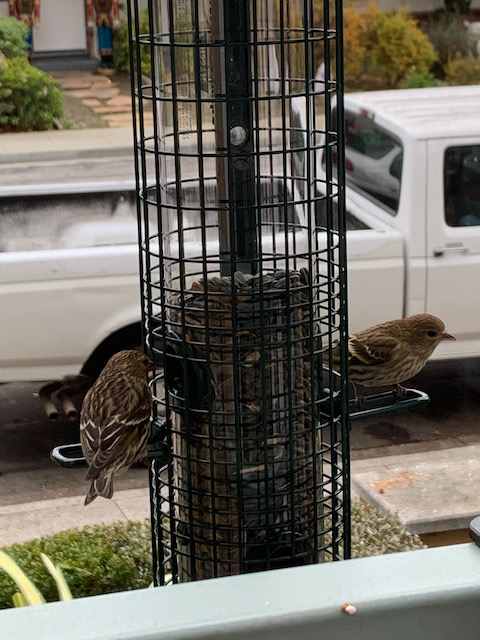
It seems pine siskins are sensitive to heat, because they used to disappear by late afternoon. In that small window of time, the house finches would come in. House finches are very nervous; they would fly away as soon as I walked into the adjacent room. But they also fought within themselves and the aggressive ones pecked the milder ones. The male birds have a pretty red tinge on their head and throat.

Fortunately for me, by May, the pine siskins were gone. It probably became too warm for them. The house finches were still there, but I also started to see lesser goldfinch, oak titmouse, and chestnut-backed chickadee.
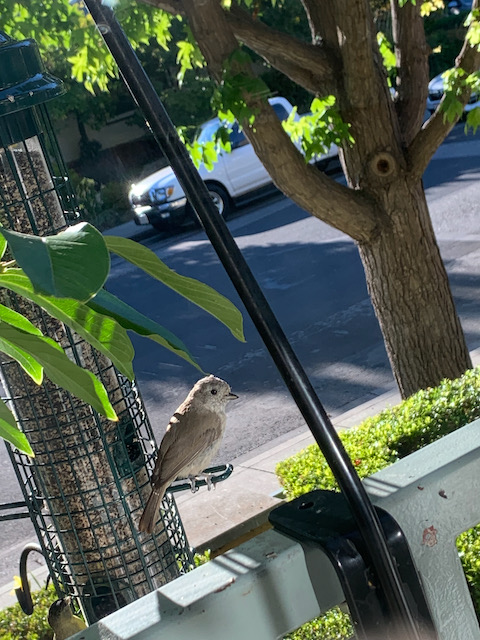
I’ve seen that titmouse and chickadee have a different way of feeding. They peck at a seed and then keep the seed between their legs. Then they continue to peck and eat that single seed. This is in complete contrast to the finches, which eat seeds directly from the feeder port. The finches’ beaks get dirty sometimes and I’ve seen them polish their beaks on twigs.
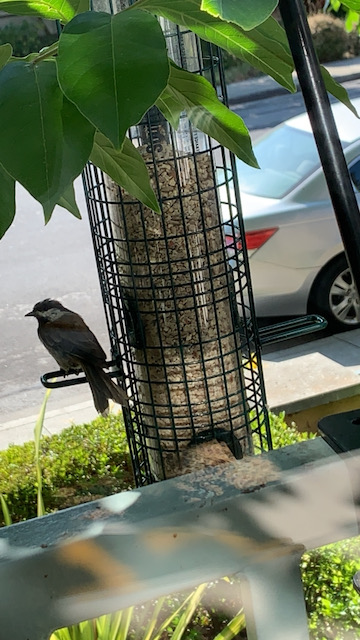
My favorite is the lesser goldfinch. First of all, it is such a bright little bird, very mild and friendly: it doesn’t fly away even if I get close, and it just sits there, eating to its heart’s content. The yellow male bird is brighter than the female green one. I have not seen this bird fight; on the other hand, it is at the lowest end of the pecking order. Every other bird chases it away. This bird seems to make a wide variety of sounds; it’s amazing that the same bird can sing so many songs.
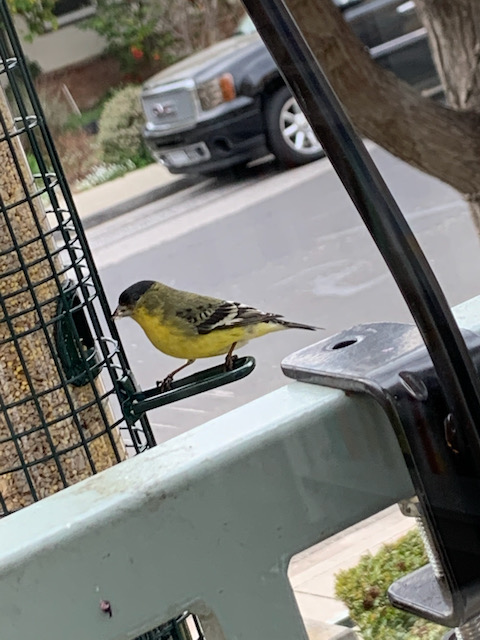
Another bird I’ve seen feed unusually is the white-breasted nuthatch. This bird feeds upside down! It perches upside down from the mesh above the feeder and then pecks at the seed.
Before I could converge into less messier feeding, there used to be a lot of seed on the ground. This attracted mourning doves. The bird is very calm while sitting, but it flies away so quickly that the change is shocking. I’ve seen these birds in pairs, and they hang around late into the evening. They look very pretty and gentle. They are not aggressive, in the sense that I’ve not seen them shoo any other bird away.
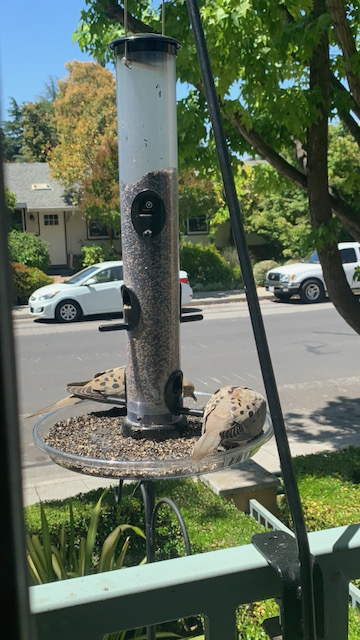
Also on the ground, I’ve seen spotted towhee and white-crowned sparrow. The white-crowned sparrow is bigger than the finch and it moves about very quickly. It has distinctive black and white stripes on its head. As it wanders around, it digs the soil with its legs and looks for food.
Another ground-feeder that occasionally used to come to the feeder above is the dark-eyed junco. This seems like a very smart bird. Once it was feeding on the plate, but then got off the plate, did its business, and then came right back to the plate to continue its meal. It apparently knows that it should not make its food dirty. Even the much bigger mourning doves were not clean like this!
The junco is also a decisive bird. It’s not nervous and it seems to know where to go and what to eat. It’s not afraid of people. It moves fast. It pecks precisely at the seed. When it’s done eating, it simply flies away very quickly: there’s no waiting or thinking about what to do next.
Sometime in April, we were fortunate to see a pair of juncos form a nest in front of our house. They carved a hole in the cypress tree and a lot happened within a few weeks. I saw both the male and the female take turns brooding and then feeding chicks. Once a parent landed on our windowsill, split up some worms, and then fed the splits to different chicks. How amazing! At another point in time, I also saw the male take droppings out of the nest. Again, this is one clean bird! I also saw a male house finch feed its chick this way.
This is apparently well understood by ravens, because they would go looking inside these trees all through the day to eat up any eggs or chicks. Because either the father or the mother was always in the nest, the junco chicks grew up fine. The ravens did take their revenge later, by pulling the nest out and dropping it to the ground. Look at the nest: it has an interior of smooth fibers, and an exterior of tough fibers. Just like us, they don’t like to be pricked while sitting in the nest.
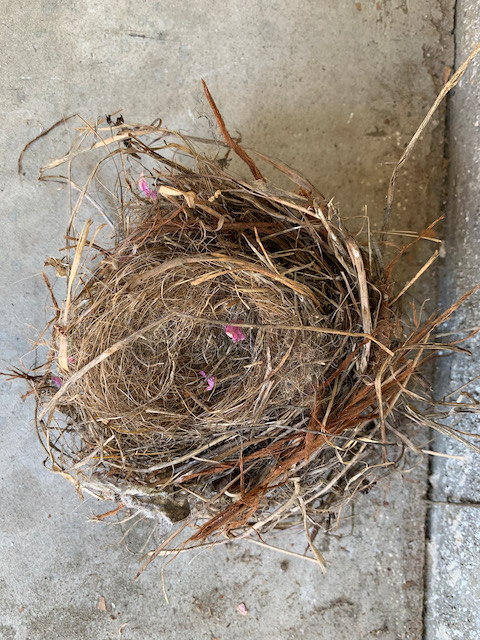
When my feed started having peanuts, it attracted nuttall’s woodpecker. Like the white-breasted nuthatch, this bird also perches on the wire mesh, but it doesn’t hang upside down. However, it likes to dine alone. It never lets any other bird feed, and its sharp beak can only help it.
As I write this in late September, it’s almost the end of summer, and I’m looking forward to when the pine siskins come back for this winter.
Tips and Advice
Identification
I used the iNaturalist app to identify the birds. This is very convenient and useful.
Bird Feeder
For best views, I like the feeder hanging just off the balcony with a slant pole. The closeness also means any bird hits don’t hurt them much (they have not yet accelerated).
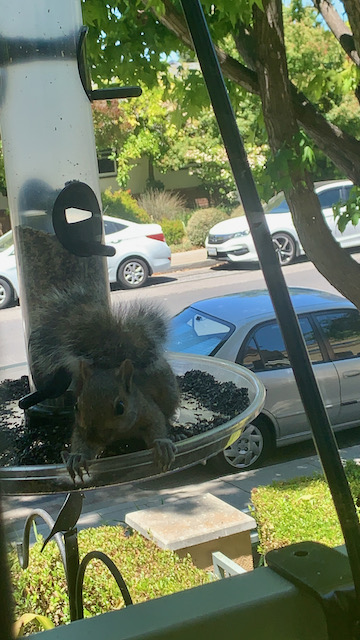
To prevent squirrels from eating the feed, I got a Squirrel Buster feeder. This closes the feed ports when a heavy squirrel tries to come down the feeder to eat.
What didn’t work for me:
- Feeder pole in the front yard (too far and low, hard to lift the feeder up to hang)
- Feeder without squirrel protection (they will eventually climb down the feeder and eat the food)
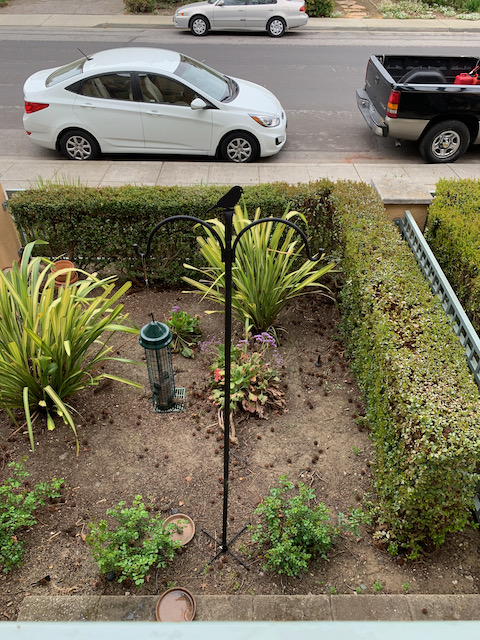
Bird Feed
To reduce wastage and to attract the most variety of birds, I get a mix of sunflower seeds (without the hull) and peanut chips from WBU.
What didn’t work for me:
- Black-oil sunflower seeds (too much wastage)
- Nyger or thistle seeds (too specialized for finches, a lot of wastage)
Cleaning
To reduce the mess below the feeder, I had to experiment with different seed mixes. Other than that, I have reduced feed time to two hours in the mornings and evenings. I also have wet wipes to clean the balcony railings periodically.
What didn’t work for me:
- Keeping the feeder out at all times (too many bird droppings)
- Seed catcher plate (attracted doves and squirrels)
- Seed catcher mesh (seemed to scare the birds away)